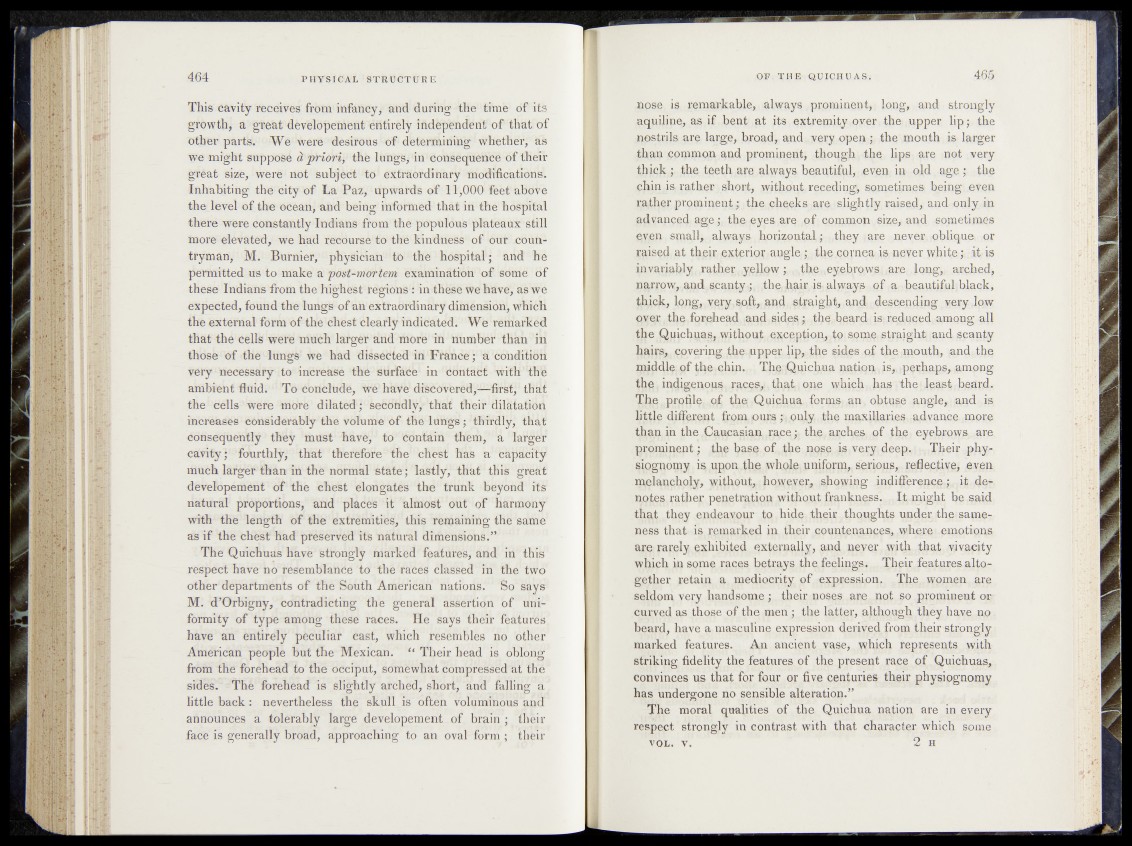
This cavity receives'from infancy,- and durih^^he thnë óf its
grow£h> a gfeat dèvelöfmment entirely îftdëpèndferif of that; of
other parts. We Werëdesirous of determining whether, hs
wemight supposé à priori, the lüögë/ümeonséqhefiëë óf tKCir
grèat size, Were not subjéct to extraordinary modifications,
inhabiting the city of La Paz, upwards of 11 >000 feet'above
the level of the Ocean, and being informed that in the hospital
there were constantly Indians from the populous plateaux still
more eleVated, we had recourse to the kindness' of our countryman,
M. Burnier, physician to the hospital1^ and he
permitted us to make a 'post-mortem examination of sömë óf
these Indians from the highest regions : in these we have', as we
expected, found the lungs of an extraordinary dimension, which
the external form of the chest clearly indicated. Wc remarked
that the cells were much larger and' morb in number than in
those of the lungs' We had dissected in'Fràhce;■'W'ccAidïtiöÜ
very necessary to increase the surface in'5CÖritëët-With’T131
ambient duid; 4T e cörielude, wé' hâvë * tÜHf
the "cells were more dilated ; Secondly/ that their'Hilatatiöii
increases considerably the volume of the lungs ; thirdly thàt'
Consequently they must have,'5 to'Contain them, -a laVgë^
cavity ; fourthly, that therefore the chest has a ‘
much larger than in the normal state; lastly, that this great
developement of the ehest elongates the trunk beyond its
natural proportions, and placés it almost out of harmony
with the length of the extremities, this remaining the same
as if the chest had preserved its natural dimensions.”
The Quichuas have strongly marked features, and in this
respect have no resemblance to the -races classed in the two
other departments of the South American nations. So says
M. d’Orbigny, contradicting the general assertion of uniformity
of type among these races. He says their features
have an entirely peculiar cast, which resembles no other
American people but the Mexican. u Their head is oblong
from the forehead to the occiput, somewhat compressed at thé
sidés.' Thé forehead is slightly arched, shortj and falling a
little back : nevertheless the skull is often voluminous and
announces a tolerably large developement. of brain ; their
face is generally broad, approaching to an oval form ; their
,nps% i| i^markahfej ^salj|§ysfyprpmjn§pt| i fopg* and strongly
aqpijfpq, as if J»pnt|,ftt its axtremj^iPyer.thefiUpperi lip; the
npstrjjft arp large, broad, and^veryppep^/the mouth is; larger
than ffpmmcn apd nrpmmpbb Though,,. the, m©t :very
h^atifahiiCVfiPx.i&v-e^d .*S@e > ;4he
phi»^§jather. sho^> S f r ^ g s j i i ^ sometimes) bpihgief.cn
pcpBalpeplai j the cheeks are slightly* raised/ and.-Qnly?in.
p||^ap9p4(:a ^ jKth§t|9ye&;are and; .fppie^m^s
even sm^li.j,alwhMftii^rWnn^d}r;?ithcy i m jpr
raisf^, jat their jg apgle^, fhc er whdjftieiVt®
inyarjahly; rather tyellow;. Vlthene^^rgtwsiiarevlQh#?>: arched»
n^rpWi.and^acapfyihr^bp^^dr/i^ial^yfopf f§'rheahtifwl|blaph>
thick;} $efy.lpw
py^r Sffififp r p h e a d f iid p g £ thqv^a,^i| S j a l l
tlie . Qpicbijaj, without exception, to t scanty
haiT^j^yei^ng.itihf4app6bhP?;the thenipnnih» sandirfm
nii44ifrpl th eiphin*f'; T ^ '$ j|ic lp& nation i s, per hap s, amo n g
thp, in^igenop^i raPCf?!*thMi whifhj<haM ftbe^f^tjbcard.
*^he nrphif; p$C th?t niphna obtain
little differpjpt hpurpur^ ,ispi4y{ the
.theiBiiii the,p^epasiapijjfasce;j the^ar,ch§§fipf |h ||| ey^pp^^are.
nrpminept: £hp basfi| of ,,the nope^.vejyideep., i ;7/£heir #hy*
siognomy ,upon.the. -whp|es ^inform,. seri°#fr; rf^leehiyg* 0 jB k
melancholy, ypthout,.* hQ^pyefii Rowing
lmte^ratf^^petmtipft without hf ifMd:
that they endeavour fp . hide; them thp^hfo undg^fthpffame^
ness that is jemai^ed in their ^ouptpnaj^e^^xfd^pLpm#^®
are rarely exhibited externally, and neypr, with that vivacity
which in some races, betrays the, feelings.., Xlieh^featMres altogether
retain a., mediocrity pf ^e^pression. The wppren are
seldom very handsome; fo«»? or
curved as those of the .men;. the l.a,ttey, ajthppgh they have no
beard, have a masculine expression derived from '
marked features. Ap ancignt vase, which represents with
striking fidelity the features of the present race of Quichuas,
convinces us that for four or five centuries their physiognomy
has undergone no sensible alteration.”
The moral qualities of the Quichua nation a re ip pyery
respect strongly in contrast with that character which some
VOL. V. ' ' , 2 H